Throughout the late 20th century, Riesling gained a somewhat tarnished reputation, particularly within the UK, as a consequence of the abundance of overly sweet, low-quality Rieslings being released onto the market. Over the past two decades, however, it has made a comeback – especially the dry styles of top-quality wines with ageing potential and great value. The high acidity and complexity of tertiary flavours in Riesling have led to it being a favourite among wine industry professionals, including Jancis Robinson, who hails it “the greatest white wine grape”.
To help you uncover Germany’s noble grape, this week we examine some iconic dry and off-dry Riesling MUST BUYs with WL scores above 95.
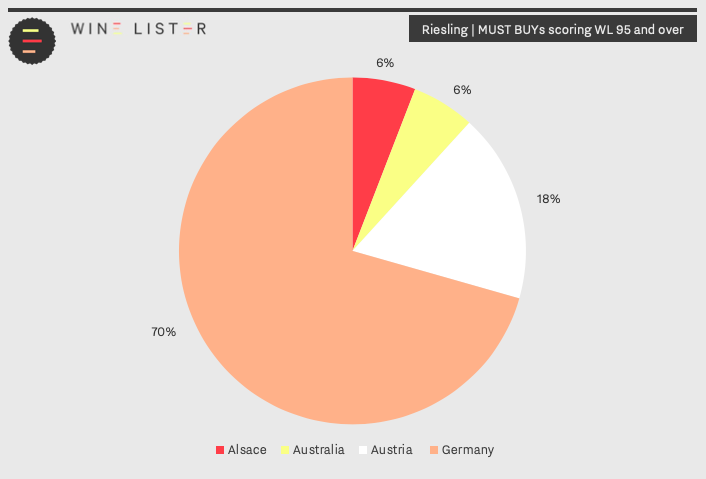
Top quality Riesling is now produced around the world, from the traditional regions of the Mosel and Alsace, through to Australia and South America. 70% of dry Riesling MUST BUYs scoring above WL 95 hail from Germany (25 wines), of which just over half (19 wines) are produced in the Mosel. The other German regions in the list comprise two entries from the Rheinhessen, and one each from the Rheingau, Nahe, and Pfalz respectively.
Austria achieves six entries on the list of Riesling MUST BUYs scoring WL 95 and over (18%), which all hail from Niederösterreich, while the Alsace and Australia’s Clare Valley both earn two entries respectively.
A Mosel Must – 2010 Joh. Jos. Prüm Wehlener Sonnenuhr Riesling Auslese Goldkapsel
With a WL Score of 97 at just £59 (per bottle in-bond), the 2010 Wehlener Sonnenuhr Auslese Goldkapsel exemplifies the excellent quality-to-price ratio of JJ Prüm’s wines. Long considered one of the Mosel’s, if not the whole of Germany’s most revered estates, its Wehlener Sonnenuhr vineyard is situated on steep south-facing, blue slate slopes, resulting in its complex minerality. Scoring it 19/20 points, Wine Lister partner critic, Jancis Robinson recounts that the 2010 vintage of this off-dry Riesling “Dances out of the glass on the nose. Such delicacy and life! Racy”. This vintage is available to purchase from Lay & Wheeler, where a case of six starts at £330 (in bond).
An essential Alsace – 2008 Trimbach Riesling Frédéric Emile
Dating back to 1626, 13 generations of the Trimbach family have contributed to the estate’s winemaking, now considered one of Alsace’s top properties. Cuvée Frédéric Emile is a blend of two Grand Cru vineyards, Geisberg and Osterberg, that share complex soils of alkaline clay and limestone, producing a wine of intense minerality. Both sites benefit from evening winds (the Tahlwendala), which allow extended ripening periods. The 2008 Trimbach Riesling Frédéric Emile achieves a WL Score of 95, and is available to purchase by the case from Cru World Wines for £390 (in bond).
A need for Niederösterreich – 2013 F.X. Pichler Riesling Kellerberg Smaragd
Described by Jancis Robinson as “Big and opulent with some lychee flavours”, the 2013 was a notably good vintage for F.X. Pichler’s Kellerberg Smaragd. Achieving the best WL Score since 1995 (96), it showcases Pichler’s attempt to refine his style and prioritise purity of fruit and balance over power. Although the narrow stone terraces of the Kellerberg vineyard necessitate farming and harvesting by hand, this wine has an impressive quality-to-price ratio. At £34 (per bottle in bond), the 2013 vintage is also a Wine Lister Value pick, and is available to purchase from BI Wines & Spirits (by the case of 12).
A New World necessity – 2013 Grosset Polish Hill Riesling
Often coined one of Australia’s most renowned Riesling winemakers, Jeffrey Grosset’s Polish Hill plot was planted in 1996, following years of research into the effect of soil, rock, and altitude on Riesling. This eight-hectare plot is thus at 460 metres altitude, ensuring cool nights and longer ripening of its Riesling grapes. Planted in an area termed “hard rock”, the Polish Hill vineyard is situated on a crust of clay over slate, which, alongside the cool growing season, causes stress on the vines, resulting in smaller but more complex-flavoured grapes. The 2013 vintage achieves a WL score of 95, and is available to purchase from Lay & Wheeler for £50 (per bottle in bond).
See the full list of Riesling MUST BUYs here.
Following our recent investigation into white Burgundy at five different price points, we now turn to red Burgundy – which represents a considerable 23% of Wine Lister’s MUST BUY hoard (376 wines).
These wines cover an even greater range of prices than their white counterparts, from £51 (per bottle in-bond) up to £15,352. Read on below for our picks of red Burgundy MUST BUYs at five different price points.
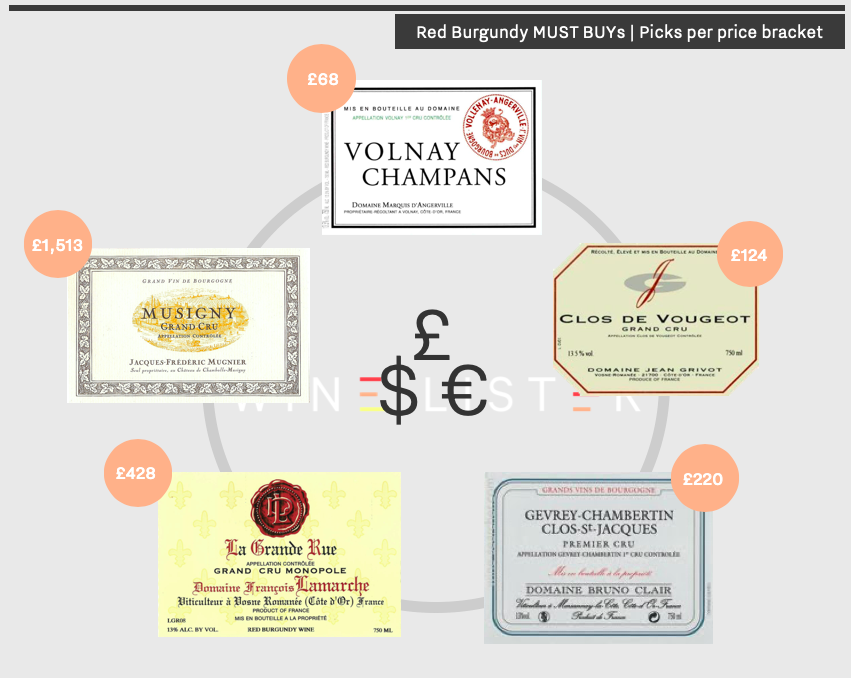 Prices are shown per bottle in-bond (when buying by the case).
Prices are shown per bottle in-bond (when buying by the case).
Under £75 – 2012 Marquis d’Angerville Volnay Champans
Marquis d’Angerville is widely considered one of the top producers in the Côte de Beaune, and the reference producer in Volnay. Indeed, the domain’s vineyards represent over 10% of all Premier Cru Volnay plantings. D’Angerville’s Volnay Champans is less than half of the cost of its flagship Volnay wine, Clos des Ducs. While both vineyards have south-easterly exposure, Clos des Ducs has calcareous, stony, white marl soil, while the soil in Champans is more clay-driven. The Champans is thus richer and fuller, while the Clos des Ducs (which also enjoys the highest elevation in Volnay) has more complexity and definition. The 2012 Marquis d’Angerville Volnay Champans performs particularly well, achieving a WL Score of 94 – this wine can be purchased from BI Wines & Spirits for £66.67 (per bottle in bond).
Under £150 – 2014 Jean Grivot Clos de Vougeot
Having taken over from his father Jean in 1990, Étienne Grivot (alongside his wife Marielle) has since adjusted his family’s viticultural and vinification methods. While completing his studies in general agriculture, viticulture, and oenology, Étienne noted that the over-fertilised Burgundian soil had become gradually less capable of producing vins de terroir. As well as reducing his overall yields, he now uses organic farming methods and natural yeasts to preserve the expression of where the grapes come from. The 2014 Clos de Vougeot has a WL Score of 94, and was described by Jancis Robinson as having “massively nuanced fruit” – this vintage can be purchased by the bottle from Wilkinson Vintners for £124 (in bond).
Under £350 – 2015 Bruno Clair Gevrey-Chambertin Clos Saint-Jacques
Bruno Clair’s Clos Saint-Jacques Premier Cru plantings are situated within a 6.7ha vineyard (shared with Sylvie Esmonin, Louis Jadot, Fourrier, and Armand Rousseau) encircled by a two-metre wall. Providing protection from prevailing winds, this fortification creates a micro-climate, which, alongside its steep south-easterly facing slope, enables consistent ripening. The 2015 vintage achieves a WL Score of 95. Wine Lister partner critic, Neal Martin describes it thus: “a hint of dark chocolate emanates from the oak infusing the red and black fruit toward the finish, and touches of marmalade and blood orange linger on the aftertaste”. This vintage is available to purchase from Cru World Wine, where the price of a bottle starts at £355 (in bond).
Under £500 – 2010 François Lamarche La Grande Rue
Having been elevated to Grand Cru status in 1992, La Grande Rue provides the setting for François Lamarche’s most prized domain – from which only c.5,500 bottles are produced per year. As of the 2007 vintage, François’ daughter, Nicole, has had total control of the winemaking, and has implemented organic viticulture (certified in 2010), which she believes makes vines more resilient to biotic stress. Described by Jancis Robinson as exhibiting “lovely freshness yet concentration and subtlety too”, the 2010 vintage achieves Lamarche La Grande Rue’s highest WL Score since its 1964 vintage (96), and is available to purchase from Corney & Barrow, where prices start at £540 per bottle (in bond).
Over £500 – 2008 Jacques-Frédéric Mugnier Musigny
Jacques-Frédéric Mugnier maintains his aim of preserving the purest expression of nature within his wine, with minimal interference from technological practices in the vineyard or the cellar. His Musigny is widely considered to be one of the greatest Burgundy reds, and has been described by Wine Lister’s Burgundy specialist critic, Jasper Morris as “brilliantly fragrant in bouquet and notably persistent on the finish”. With a WL Score of 96, the 2008 Jacques-Frédéric Mugnier Musigny is more difficult to source than the preceding wines, however, it is worth informing your merchant of your interest in purchasing it.
In 2004, WL partner critic Jancis Robinson published an article, “Pink champagne – fashionable but too often dire”, whose title summarises the contemporaneous consensus surrounding rosé Champagne. Long-regarded by Champagne producers as a subsidiary wine – one without the required levels of attention placed on their primary project – its quality often fell short.
15 years later, in September 2019, Robinson conversely wrote a piece titled “Pink champagne – a serious wine now”, outlining the attentive methods of production, and the consequential calibre of rosé Champagne amongst its top producers.
This week’s blog post investigates the victorious return of rosé Champagne, as we examine the upward quality and price trends across 10 of its top brands when compared to their white counterparts.
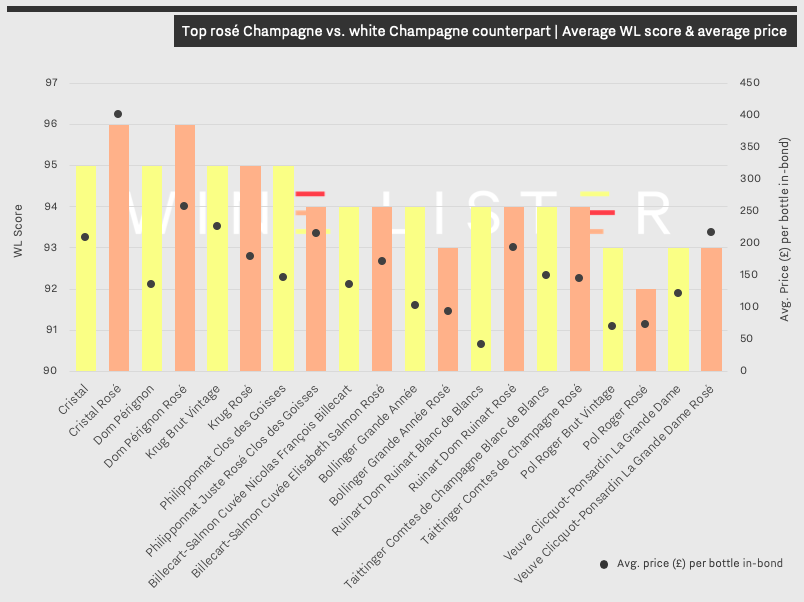
The chart above shows the average WL Score and average price for “pairs” of wines from 10 top rosé Champagne producers whose range includes a rosé.
An initial look at the selected wines reveals the recurrent pattern of rosé Champagnes costing more than their white counterparts, with the exception of Krug Rosé, Bollinger Grande Année Rosé, and Taittinger Comtes de Champagne Rosé. The mean price difference between the two styles of the respective wines is substantial nonetheless, with rosé Champagne costing 46% more on average than its white equivalent (an average of £195 for rosé and £134 for white).
Excluding Pol Roger’s Rosé and Bollinger’s Grande Année Rosé (whose white equivalents supersede them by one WL point), the rosé Champagnes featured above achieve equivalent or higher WL Scores than their white counterparts.
Cristal Rosé is a blend of 55% Pinot Noir and 45% Chardonnay grapes. With a WL Score of 96, at an average price of £401 (per bottle in-bond), this wine is almost double the price of Cristal, which has a WL Score of 95 at £203. Consequential of the generally lower yields of Pinot Noir in continental conditions, Cristal Rosé is Louis Roederer’s rarest and thus most expensive wine, produced solely in years when the grapes have attained perfect maturity.
Similarly made in only exceptional vintages, Dom Pérignon Rosé is considered by its producer to characterise its growing year, hence the fluctuating ratio of Pinot Noir and Chardonnay grapes from vintage to vintage. With a WL Score of 96, at an average price of £277 (per bottle in-bond), Dom Pérignon Rosé is over double the price of its white counterpart. Dom Pérignon Vintage Brut has an average price of £131 and has one less WL Score point than its corresponding rosé wine.
As indicated by its Vintage Value Identifier chart, the 2002 Dom Perignon Rosé exhibits significant quality and value, with a WL Score of 98. Jancis Robinson awarded this wine 20/20 (a rare occurrence), describing it as “pungent and composed with massive energy” – a far cry from her 2004 article. Rosé Champagne has most definitely made a comeback.
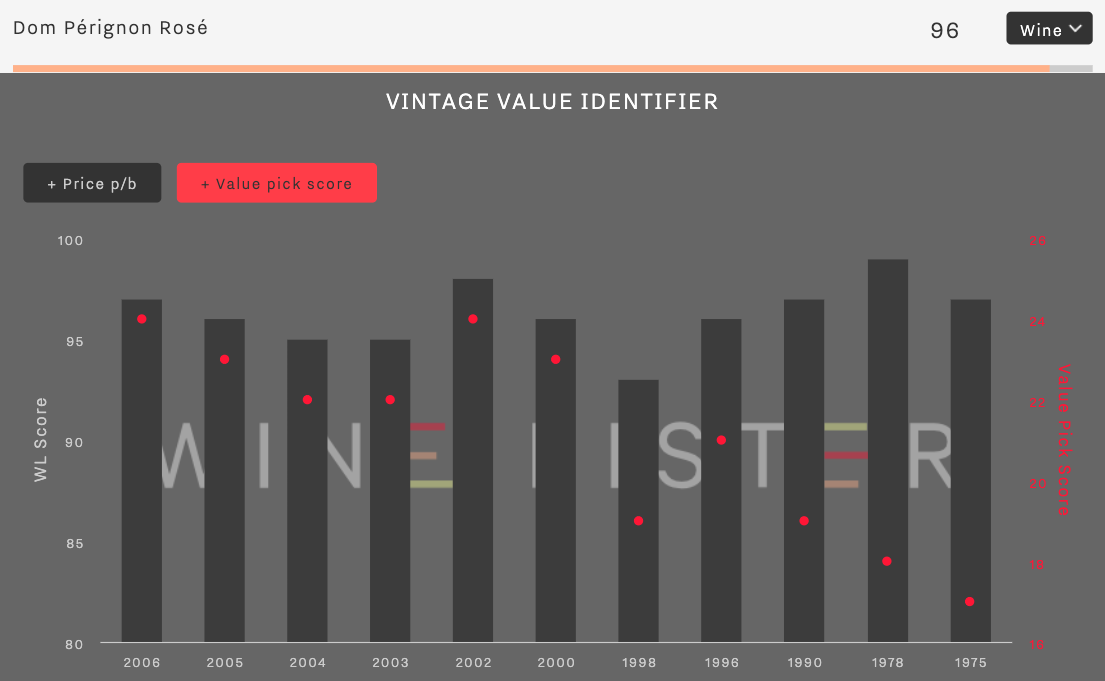
The 2002 Dom Pérignon Rosé can be purchased from Berry Bros & Rudd, where a case of three starts at £1,200 (in-bond).
Like a virtual treasure map, Wine Lister’s Hidden gem indicator helps you discover fine wines that are under the radar, yet worth uncovering. These wines are seldom found in the top restaurants, infrequently searched for online, but have high ratings from wine critics, or are assigned “Hidden gem” status by the global fine wine trade.
Of the 1,639 wines that are currently recognised as MUST BUYs by Wine Lister’s proprietary recommendation algorithm, 87 are Hidden gems. To help you uncover these underrated wines, this week we examine the Hidden gem MUST BUYs with WL scores above 95.
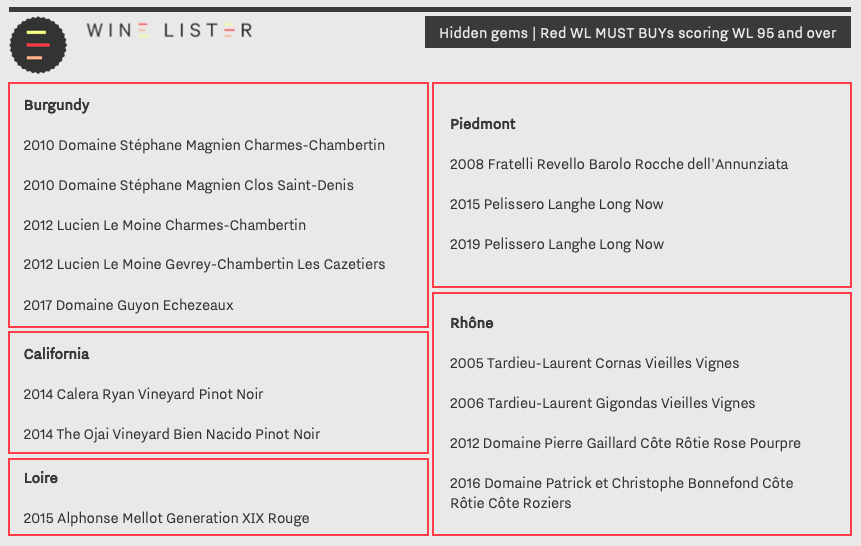
A preliminary look at the elected wines reveals a common trend of lower-than-average prices. While achieving WL scores of 95 and over, the 15 red Hidden gems illustrated above have an average price of £67 (per bottle in-bond) – perhaps a consequence of their slight obscurity. By virtue of being “Hidden gems”, these wines are also harder to source, however, it is worth informing your merchant of your interest in purchasing them, in the event of their availability.
Burgundy achieves five entries in this week’s subgroup, with two from a small-production négociant house, Lucien Le Moine. Well-deserving of their Hidden gem status, both wines achieve a WL score of 96. The 2012 Lucien Le Moine Charmes-Chambertin is available from Lay & Wheeler at £173 (per bottle in-bond), and the 2012 Lucien Le Moine Gevrey Chambertin Les Cazetiers can be purchased from BI Fine Wine & Spirits for £83 (per bottle in-bond).
California is represented by two wines of the same vintage and grape. The Ojai Vineyard Bien Nacido Pinot Noir 2014 hails from vines in Santa Barbara’s Santa Maria Valley, whose east-to-west face encourages the flow of cooling Pacific Ocean breezes, apt for the Burgundian variety. The Ryan Vineyard Pinot Noir 2014 from cult California producer, Calera, is produced from vines in several sites across the Central Coast.
Two entries from Rhône’s Tardieu-Laurent show notably good quality-to-price ratios, achieving “Value pick” status. With a WL Score of 96, the 2005 Cornas Vieilles Vignes is priced at £43 (per bottle in-bond), while the 2006 Gigondas Vieilles Vignes has a WL Score of 95 at £24.
A joint venture between two négociants, Dominique Laurent (of Burgundy fame), and Michel Tardieu (Rhône), Tardieu-Laurent is a boutique négociant operation. Buying young wines from growers across the Rhône, the domain completes maturation and blending, before bottling with no fining nor filtration. The 2005 Tardieu-Laurent Cornas Vieilles Vignes is available to purchase from Fine + Rare (in magnum form), and the 2006 Tardieu-Laurent Gigondas Vieilles Vignes can be bought from Wine Bourse (by the case of 12).
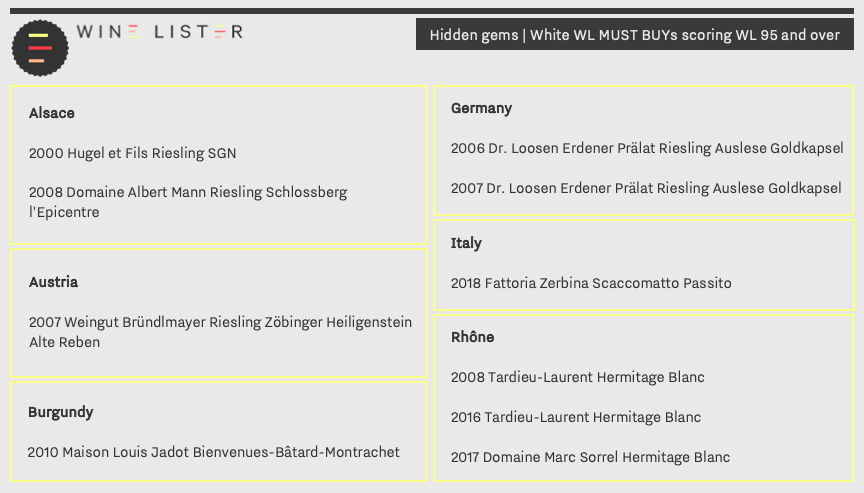
Tardieu-Laurent also features twice on the list of white Hidden gem MUST BUYs, with both its 2008 and 2016 Hermitages Blancs achieving WL Scores of 95.
Like their red counterparts, Tardieu-Laurent’s white Hidden gems are Value picks. Jancis Robinson pays compliment to both vintages, describing the 2008 as “Clean, intense, multilayered”, and the 2016 as “Very serious stuff”. Both wines can be purchased from Corney & Barrow (by the case of 12 in-bond).
Five out of the 10 white Hidden gems shown above are Riesling-based. There is no doubt that the noble grape can produce impressive quality wines at reasonable prices, though this remains somewhat of a fine wine trade secret (when compared with the consumer popularity of other white grape varieties and styles).
The two whites from Alsace cover icon Riesling producers Hugel and Albert Mann. Germany’s entries comprise of the 2006 and 2007 vintages of Dr. Loosen Erdener Prälat Riesling Auslese Goldkapsel, which achieve WL Scores of 96 and 95 respectively.
Loosen’s four-acre Erdener Prälat vineyard has south-facing red slate soils, and a notably warm microclimate, which, combined with the warming effect of the river and the heat-retaining cliffs that surround it, ensures ripeness in every vintage. The 2006 Dr. Loosen Erdener Prälat Riesling Auslese Goldkapsel can be purchased from Lay & Wheeler for £47 (per bottle in-bond).
To discover more of Wine Lister’s Hidden gem MUST BUYs, click here.
Last week’s blog post examined two of the most popular Wine Lister website features amongst collectors: the MUST BUY recommendation tool and the Compare Tool. Wine Lister’s Vintage Value Identifier helps the modern wine collector to further refine their online investigations.
Featured on each wine page, the dynamic Vintage Value Identifier gives a clear visual of quality-to-price ratios across the vintages of a given wine, and applies a Value Pick Score to measure the relative value.
By performing the price analysis for you, this tool pinpoints exact vintages of your favourite wines that are the best options to buy or sell, based on the impressive quality for their price.
See the example of Montrose below, or by exploring its wine page here.
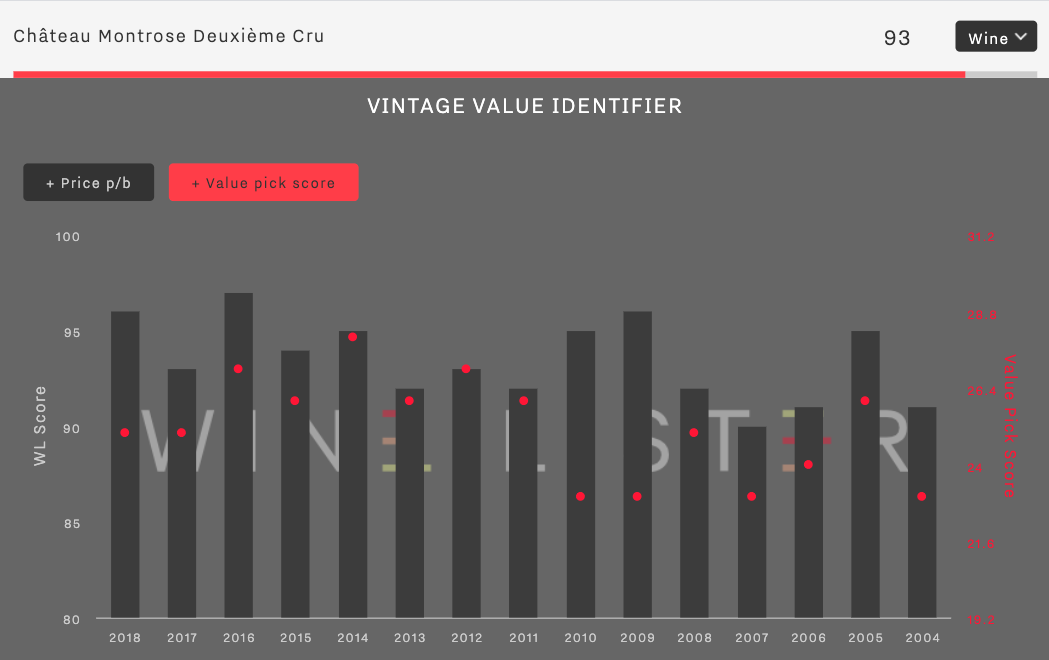
As indicated by the red dots, and values on the right-hand axis, Montrose’s Value Pick Score fluctuates between vintages. The 2004, 2007, 2009 and 2010 vintages share the lowest Value Pick Score (23), while the 2014 Montrose achieves the highest score of 28.
The 2014 vintage tends to represent excellent value across the board in Bordeaux. This is due to its good (if not excellent) quality overall, and its release after the lesser-quality 2013 (which kept release prices down). Montrose’s 2014 was awarded 96 points by Wine Lister partner critic, Neal Martin, who notes, “a bouquet that exudes class and sophistication: pure and mineral-driven black fruit, cedar and pencil lead, hints of blueberry developing with aeration although it never impedes upon the sense of terroir”.
While the true benefit of the Vintage Value Identifier lies in the Value Pick Score, it is still possible to view the pure price vs. quality analysis, as illustrated below:
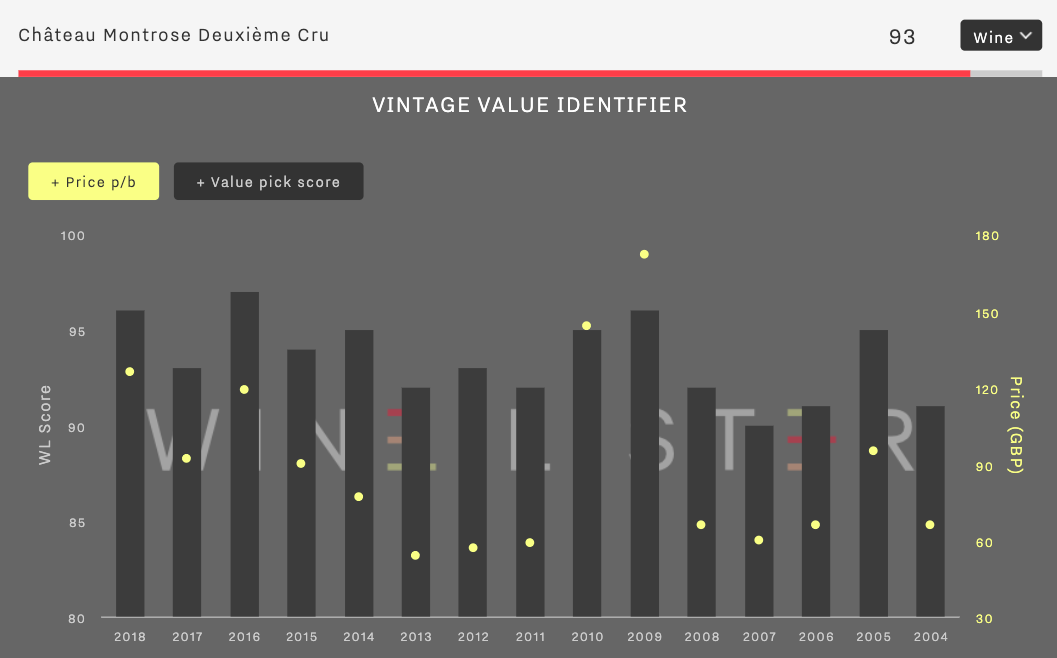
While Montrose 2009 achieves the second-highest WL Score of the featured vintages, it also commands the highest price (£172 per bottle in-bond, when buying by the case). Achieving MUST BUY status, the 2014 vintage is conversely priced at £77 per bottle in-bond for a similar level of quality (hence the higher Value Pick Score). The 2014 Montrose is available to purchase from Corney & Barrow, Cult Wines, Justerini & Brooks, and BI Fine Wines (the latter in magnums only).
Guiding your future purchases, you can identify good value in back vintages of any wines by using the Vintage Value Identifier on each wine’s page. Click here to start your own analysis.
Wine Lister is currently offering a range of portfolio analysis services to private clients. If you are interested in having your wine collection analysed by our team of fine wine data experts, please don’t hesitate to contact us.
An Easter weekend on lockdown presents as good a time as ever to evaluate your wine collection. While it can be tricky to keep track of what you’ve got and when you should drink it, Wine Lister’s various online tools allow detailed analysis of your collection and can guide future purchases, whether for drinking or investment.
This week’s blog post examines two of the most popular Wine Lister website features amongst collectors, starting with the MUST BUY recommendation tool.
Wine Lister’s proprietary recommendation algorithm produces a dynamic list of wines with high quality that show value within their respective vintages and appellations, helping wine lovers buying at almost every level to make the best choices for their desired region, style, or vintage.
There are currently 1,665 MUST BUYs out of the 30,000+ labels on Wine Lister. See the chart below for a breakdown of MUST BUYs by region – an indication of what a diverse portfolio could look like for the modern collector.
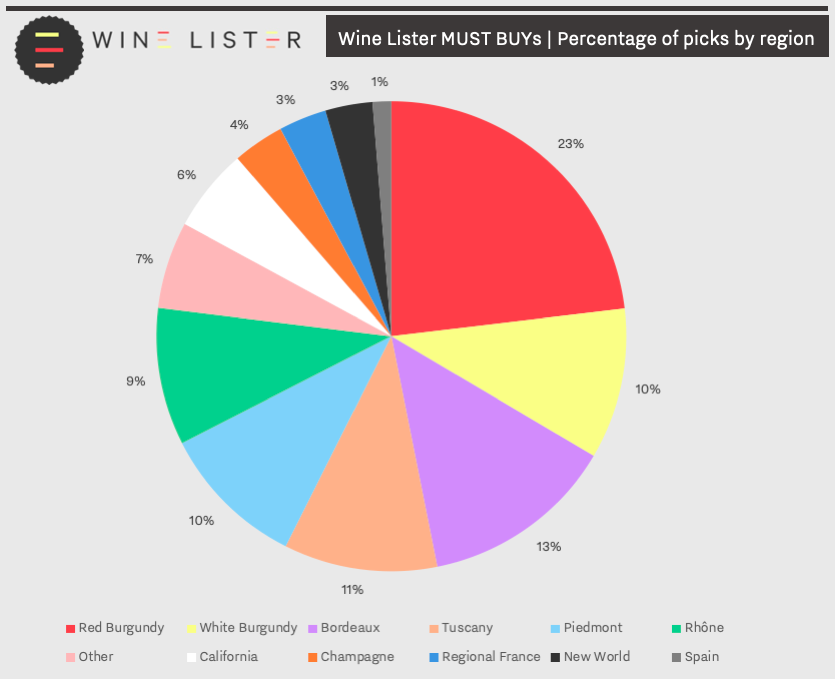
While the same chart from a decade ago may have been dominated by Bordeaux, the global demand and secondary market values for Burgundy’s top wines have continued to spiral upwards. Burgundy represents the greatest percentage of MUST BUY wines, with red and white recommendations accounting for 33% of all MUST BUYs collectively. The red Burgundian MUST BUYs feature a range of prices starting from the most expensive, DRC’s Romanée-Conti 2015 (available at £14,500 per bottle in-bond), down to 64 wines priced at £100 or under, including Stéphane Magnien’s Clos Saint-Denis 2010 (available at £76 per bottle).
Bordeaux represents 13% of MUST BUYS, and also encompasses a wide range of prices, from six vintages of Petrus (with an average price of £1,990 per bottle) down to two vintages of Marsau (priced at £12 and £13 respectively). Tuscany, Piedmont, and the Rhône follow closely behind, while California makes up the largest proportion of New world MUST BUYs.
With so much MUST BUY choice available, you may wish to filter these by top regions, and then further by Wine Lister Indicator. For example, filter results by ‘Investment staples’ to see wines that are long-lived (but not too old), and have proven wine price performance, while staying relatively stable and liquid.
Wine Lister’s Compare tool can then further refine your investigation, by displaying your selected MUST BUYs side by side. This is illustrated below using three 2016 Saint-Estèphe MUST BUYs – Cos d’Estournel, Calon Ségur, and Montrose. While Calon Ségur appears to be the best value, Montrose has the highest scores from Wine Lister’s partner critics, and therefore the better WL score overall.
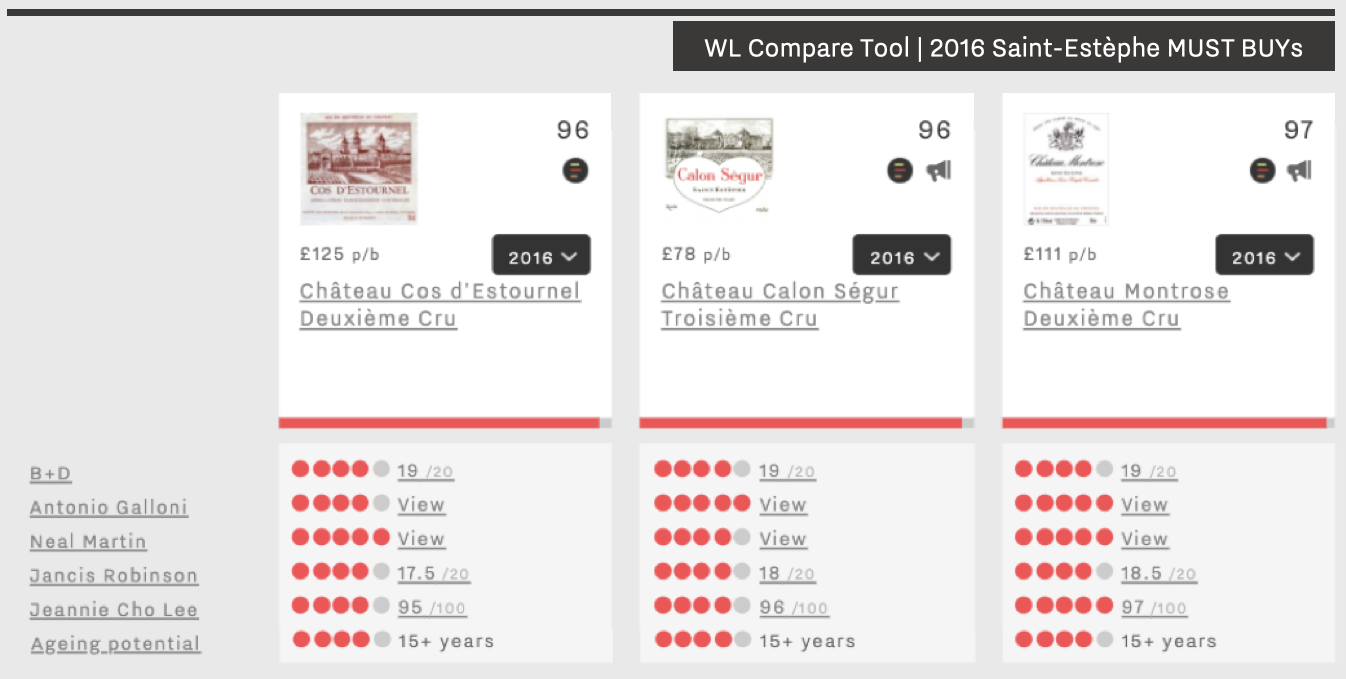
See the above comparison for yourself, or start your own wine comparison here.
Wine Lister is currently offering a range of portfolio analysis services to private clients, from detailed geographical split and further purchase advice, to investment forecasting and a fully-fledged “drink vs. sell” plan. If you are interested in having your wine collection analysed by our team of fine wine data experts, please don’t hesitate to contact us.
While the world continues to tackle the outbreak of Covid-19, we at Wine Lister are trying to continue with “business as usual” – at least as far as is possible, while also thinking of all our friends in wine regions and markets that are struggling in this uniquely difficult time. This of course includes California – that idyll for sunshine and free love as featured in many a hit song and many a hit wine list.
Of all fine wines from the New World, offerings from California have succeeded in grabbing the attention of fine wine collectors, with some even reaching “cult” status. With this in mind, we are California dreaming this week, and examine below the wines from California’s foremost regions – Napa and Sonoma Counties.
Both production areas offer an abundance of top-quality wines, though at a price. The high prices of several Napa County AVAs, including Oakville and the Napa Valley, mean that its wines can appear expensive when compared to its sibling, Sonoma County.
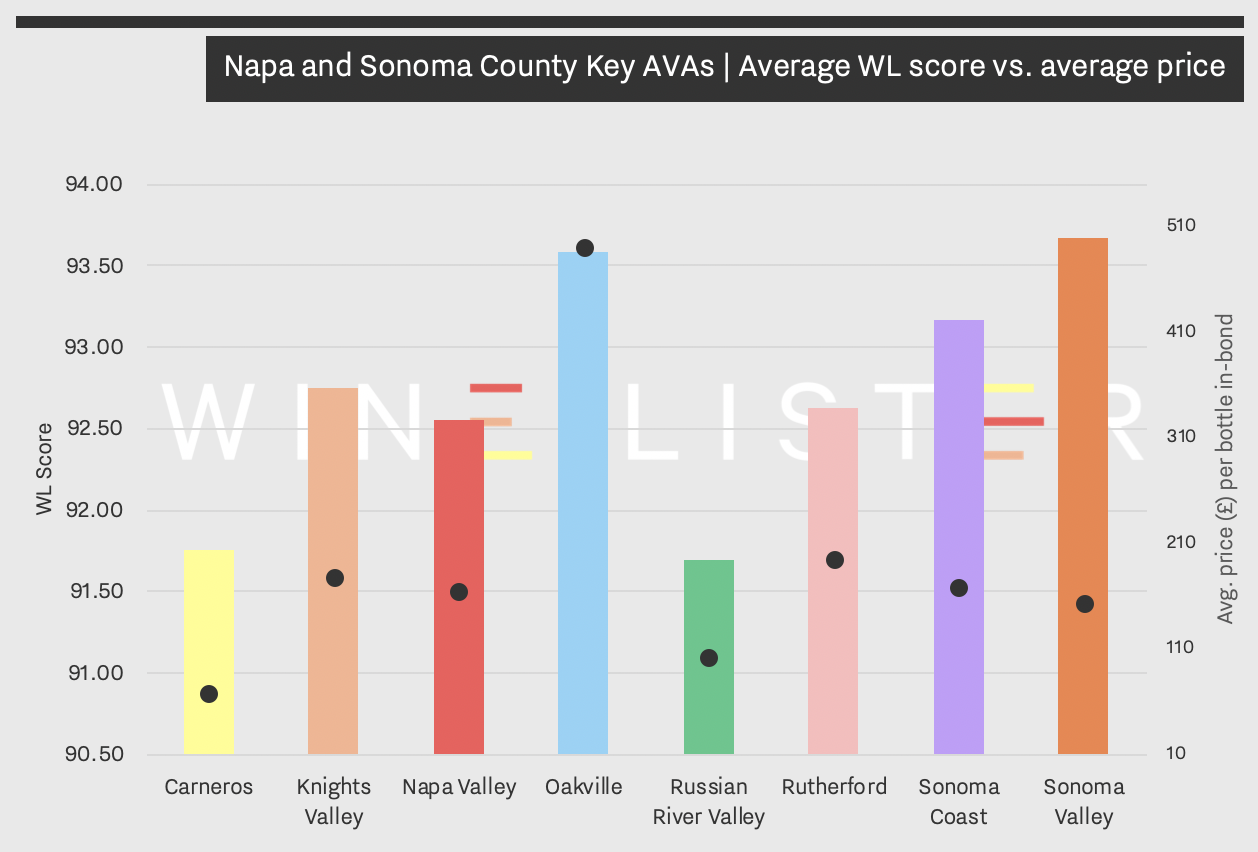
The chart above shows the average WL Score and price (£) per bottle in-bond (when buying by the case) of the top eight AVAs in Napa and Sonoma Counties.
Two AVAs consisting only of white wines stand in stark contrast. Carneros is represented by four Chardonnays – Kistler Vineyards’ Hudson Vineyard, Ramey Wine Cellars’ Hudson Vineyard, Shafer Vineyards’ Red Shoulder Ranch, and Cakebread’s Chardonnay Reserve, earning an average WL score of 91.8. Accompanying its relatively low WL score is the second-lowest average price of all AVAs – c.£67 per bottle in-bond. This remains excellent value in the wider fine wine context, given that Chardonnay with similar scores from Burgundy can fetch up to c.£1,000 (for example, Coche-Dury’s Meursault Les Caillerets).
At the other end of the quality scale is Sonoma Valley AVA, represented by three Chardonnays from Kistler Vineyards. Its average WL score of 93.7 is the highest amongst its Californian peers. Considered a cult Californian winemaker, the Kistler Winery emulates the Burgundian “terroiriste” approach, committing wholeheartedly to wines that best reflect each individual plot.
The Napa County groups command a higher price tag on average than their Sonoma counterparts. Oakville’s selection of predominantly red wines holds the second-highest WL score, however its average price is over double that of the second most expensive region – Rutherford. This is explained by the presence of Screaming Eagle Cabernet Sauvignon, which, at an average price of £2,863 per bottle, drives the region’s quality-to-price ratio down. The mailing list model of Jean Philips’ low-production Napa Valley winery has amassed an incredible cult following of fine wine buyers, who seemingly seek access to the wine at any cost.
While Sonoma County may appear to offer the better value (with red wines such as Kenwood Vineyards Artist Series Cabernet Sauvignon, or Hirsch Vineyards Block 8 Estate Pinot Noir, to add examples to Kistler’s whites), Wine Lister’s top 10 Californian MUST BUYs are all from Napa County.
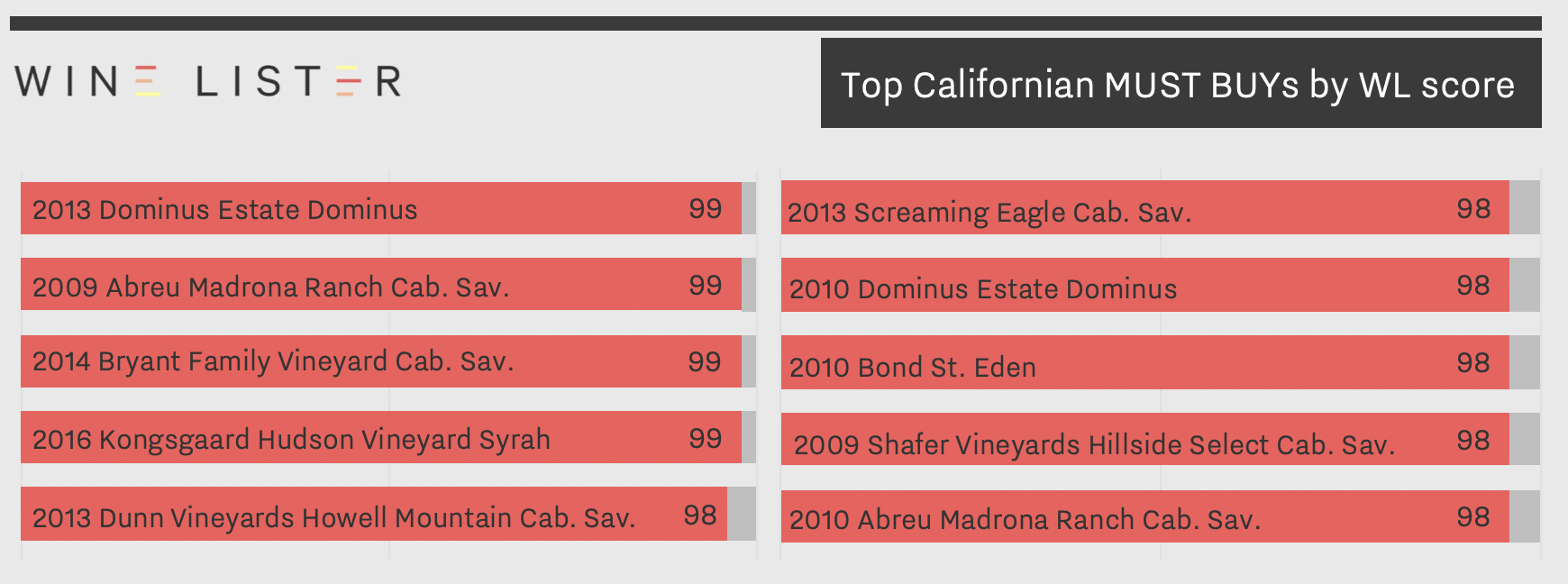
Of these, all are produced in the Napa Valley AVA except Screaming Eagle’s 2013 Cabernet Sauvignon. Dominus Estate achieves two mentions, with vintages 2013 and 2010 both featured. Perhaps unsurprisingly for the New World king of Cabernet Sauvignon, the top 10 Californian MUST BUYs includes just one alternative grape variety – Kongsgaard’s 2016 Hudson Vineyard Syrah.
Explore all 94 Californian MUST BUYs here.
While the outbreak of Coronavirus continues to threaten the global stock market and international commerce, it is understandable that the fine wine trade and collectors alike are feeling the pressure, not to mention wine producers – especially in hard-hit Italy. The cancellation and/or postponement of wine fairs across the globe may hinder new releases from catching their usual momentum, but those with significant back stocks of older vintages may have a way to navigate today’s choppy seas.
Wine Lister has been working on a new tool to complement WL MUST BUYs, and while now may not be the perfect time for such a release, we launch it in the hope of providing inspiration for the sale and purchase of wines that could be hiding In Stock, and in a continued effort to support producers and the wine trade during difficult times.
The new tool, Wine Leagues, provides hit lists of the very best wines to source for a given set of criteria, be it appellation, price, or WL score. We hope the top 10s on this new page will speak to all fine wine lovers, be it for “unicorn” wines, or just ultra-high quality wines that any collector should consider for their collection.
The current set of Leagues examines Italy, with the first list focusing on its top Value Picks. The top 10 Italian Value Picks hail from a handful of key producers – Fontodi, Isole e Olena, and San Giusto a Rentennano feature multiple times.
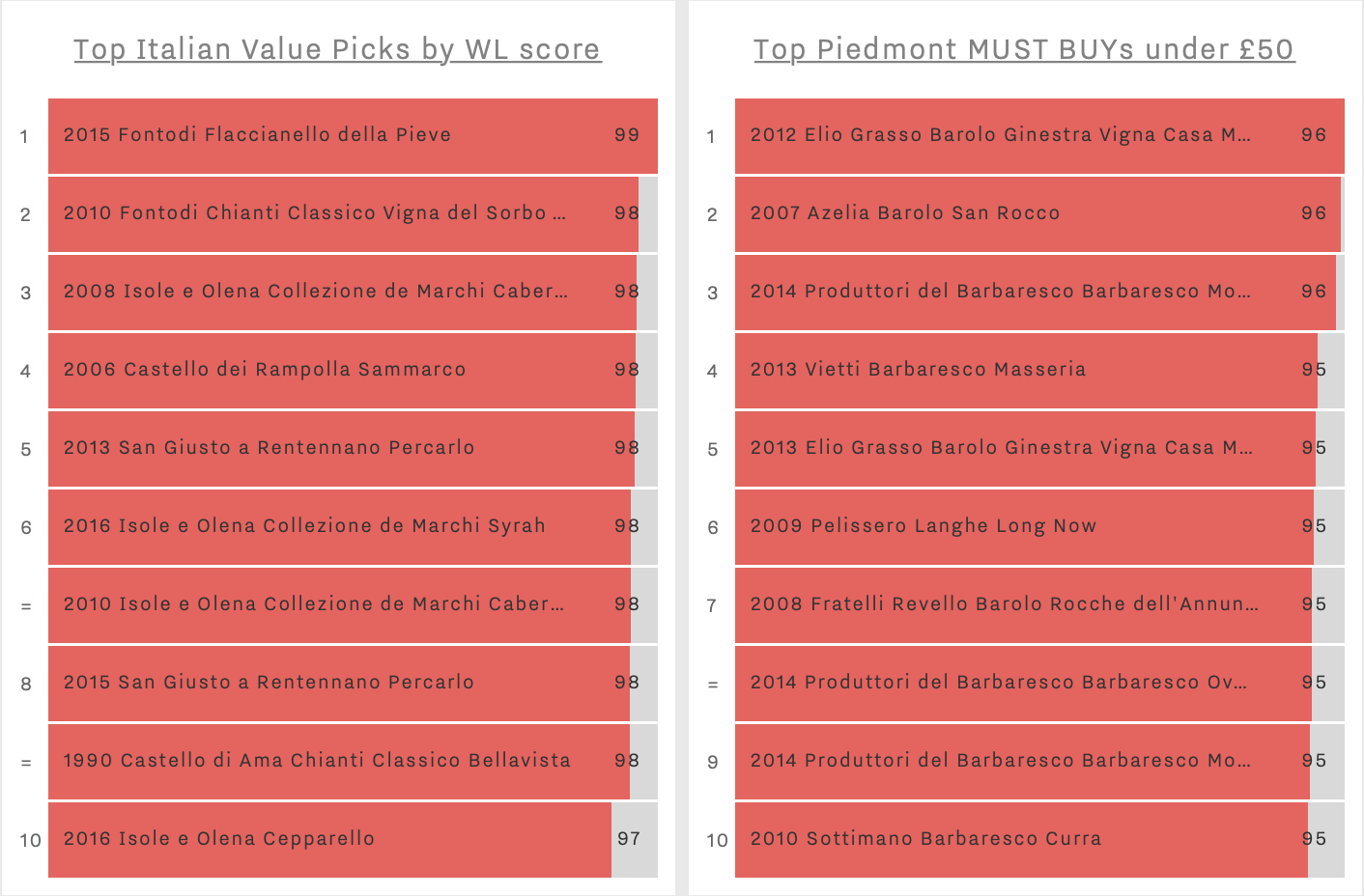
Barbaresco recommendations take the majority of top spots in Piedmont’s MUST BUYs under £50 (per bottle, in-bond when purchased by the case). Barolos from Elio Grasso, Azelia, and Fratelli Revello also make the cut, alongside Langhe offerings from Vajra and Pelissero.
Moving into France, we examine Hidden Gems from the Rhône, and Value Picks from Bordeaux. Tardieu-Laurent features three times in the Rhône Hidden Gems’ top 10 by WL score, for an Hermitage Blanc, a Gigondas, and a Cornas. Three Côte Rôties make it into the top 10, from producers du Monteillet, Pierre Gaillard, and Patrick and Christophe Bonnefond.
Top Bordeaux Value Picks render a number of deliverable vintages going back as far as 1995, as well as two wines from the latest en primeur release – Barde-Haut and Latour-Martillac 2018s. Super-second growth Pichon Comtesse’s second wine also features. The 2016 Réserve de la Comtesse was recently highlighted in a focus on Bordeaux MUST BUYs.
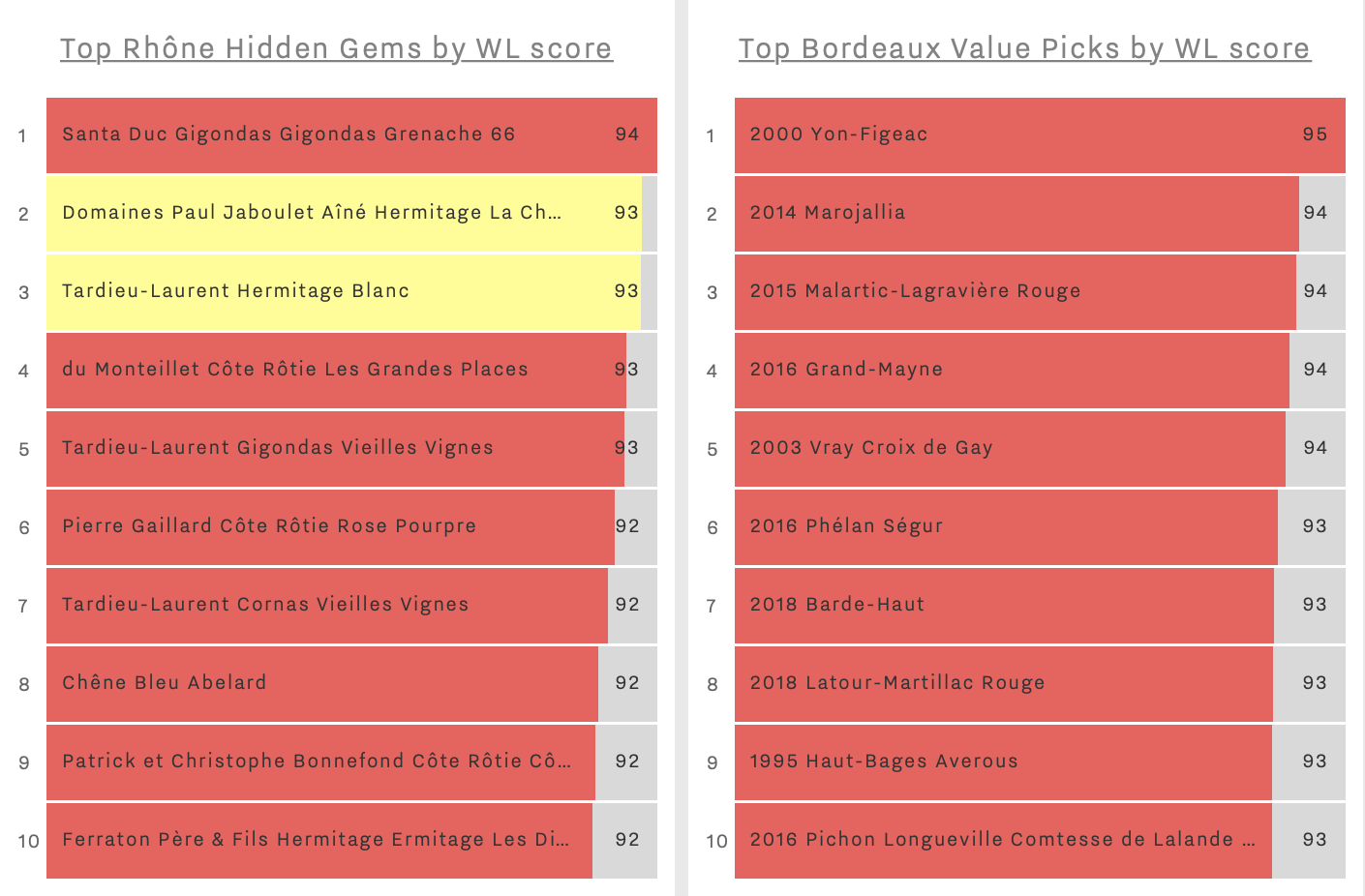
All users can see the standard Wine League page here. Pro users have access to a more extensive set of Leagues, and can log in to access here.
Faced with a new generation of fine wine buyers seeking more of the “weird and wonderful”, let alone recent economic obstacles – Coronavirus keeping drinkers off the streets, US tariffs on European wines – Bordeaux can struggle to find space to thrive.
Bordeaux’s traditional image compared to more fashionable regions such as Burgundy, Piedmont, or Champagne means its prices are lagging behind. The silver lining is that Bordeaux appears excellent value for the high quality available in comparison.
Wine Lister’s dynamic buy recommendation tool currently identifies 219 Bordeaux wines as MUST BUYs – just 19 fewer than the original MUST BUY list from September 2019.
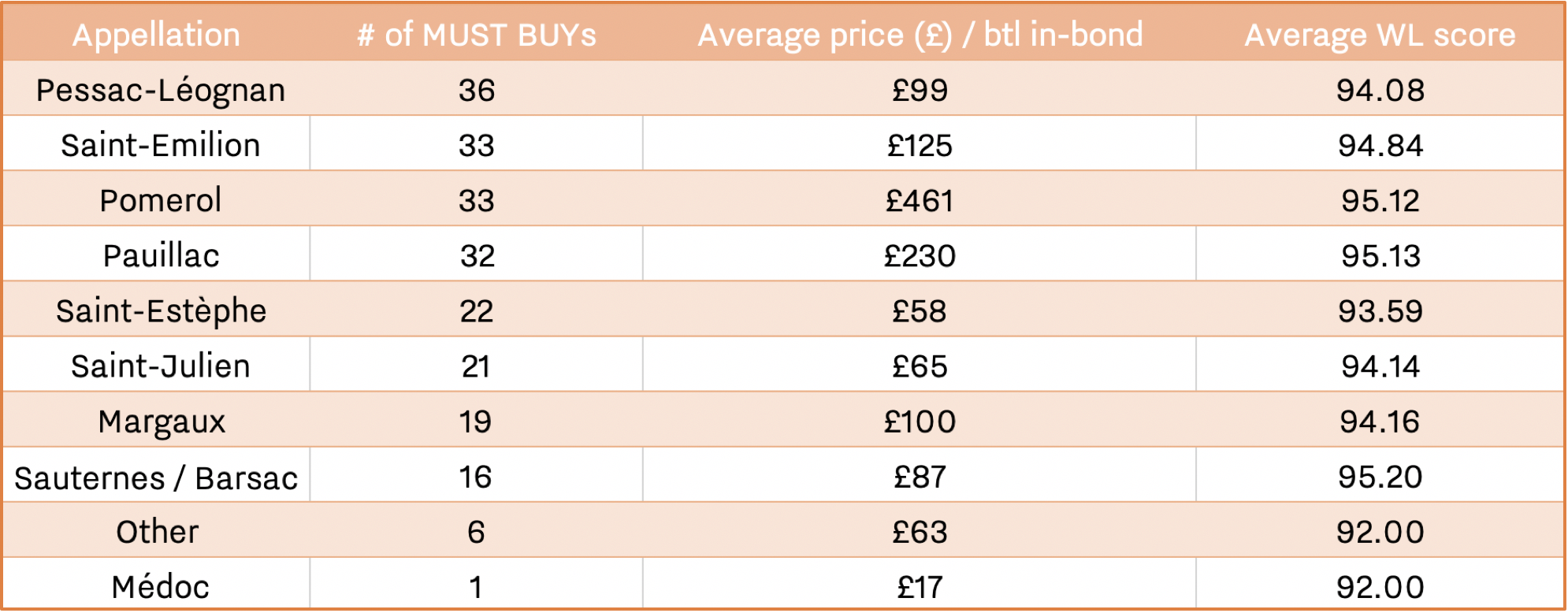
The above table shows each Bordeaux appellation by number of MUST BUYs, as well as average price and WL score of each MUST BUY appellation group. Marking the delayed opportunity presented by slow price evolution post-en primeur, 2016 is the most-featured vintage, achieving 40 entries out of the 219 Bordeaux MUST BUYs (or 18%).
Leading MUST BUY appellation Pessac-Léognan is made up of 28 reds and eight dry whites. Producer Domaine de Chevalier features particularly heavily, earning MUST BUY status for 1981, 2009, 2014, 2015, and 2018 for its red wine, and 2004, 2009, 2010, and 2013 for white. Its second red wine, L’Esprit de Chevalier, appears for the 2016 vintage.
Smith Haut Lafitte and La Mission Haut-Brion share the remaining white places between them, while Haut-Bailly, Haut-Brion, Latour-Martillac, and Malartic-Lagravière achieve multiple entries for reds only. Price-rising superstar Les Carmes Haut Brion features for just one vintage – the 2017.
Right bank appellations Saint-Emilion and Pomerol share second place, with 33 MUST BUYs each. They both earn slightly better average WL scores than Pessac-Léognan, but at prices 26% and 366% higher respectively on average than Pessac counterparts.
The large price difference is hardly surprising in Pomerol, given that its MUST BUY hoard includes five vintages of Petrus, and one of Le Pin. Without these, the average price of Pomerol MUST BUYs is £171, and there are still options at the more affordable end (such as 2016 Vray Croix de Gay).
Powerhouse Pauillac comes next, and includes 14 first growth entries. Mouton takes the lion’s share of these, featuring seven vintages from 1996-2018. Latour earns five places (including one much older vintage – 1964), and Lafite two. Pichon Comtesse also features heavily, earning five MUST BUYs for its grand vin, and one for the Réserve de la Comtesse.
In terms of pure value for money, the one MUST BUY from the Médoc appellation – Potensac 2018 – wins out, followed more generally by Saint-Estèphe’s 22 MUST BUY entries. Perhaps unsurprisingly, its crowned king is Calon Ségur, earning MUST BUY status for five vintages – 2005, 2009, 2014, 2015, and 2016.
Explore all 219 Bordeaux MUST BUYs here.
This week Wine Lister published its first in-depth study of 2020, focusing on the leading wines and producers of Piedmont.
The key takeaways from the report prove Piedmont to be somewhat of an enigmatic region, earning high praise from critics, and experiencing strong long- and short- term price performance, while still lagging behind in terms of consumer popularity.
While this is perhaps a consequence of Nebbiolo’s relative obscurity when compared with international grape varieties, Piedmont’s unique position – a veritable treasure trove of gems to uncover – presents a real opportunity both for vinous discovery and future value.
Wine Lister Pro members can read the full Piedmont report here. All free users can purchase the report for £200 from Wine Lister’s Analysis page.
Below we examine the top Barolos and Barbarescos by WL score.
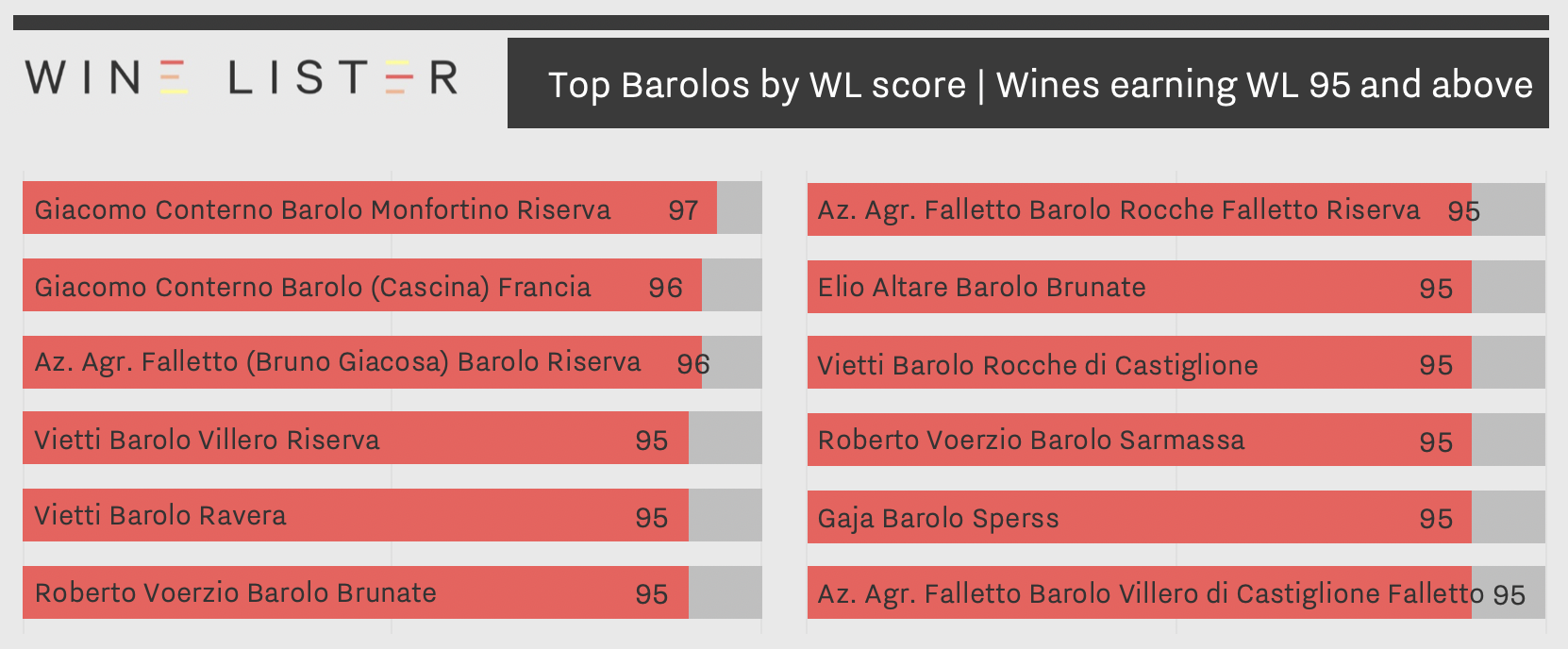
Giacomo Conterno takes both first and second places in the ranking of Barolos by WL score. The icon wine, Barolo Monfortino Riserva is the only Piedmont wine to earn a WL score of 97, while the Barolo Francia shares its score of 96 with the Barolo Riserva from the legendary Bruno Giacosa’s négociant outfit, Azienda Agricola Falletto, as well as the two highest-scoring Barbarescos (see below).
While earning joint-second place for the straight Barolo Riserva, Falletto also features for two site-specific bottlings, the Barolo Rocche Falletto Riserva and Barolo Villero di Castiglione Falleto, making the renowned house the joint-most prolific producer in the top Barolo rankings shown. It shares this position with Vietti, which earns WL 95 for its Villero Riserva, Ravera, and Rocche di Castiglione Barolos.
Elio Altare’s Barolo Brunate is the most reasonably priced of these top 12 Barolos, with an average price of £112 per bottle in-bond (when purchased by the case). Both of Roberto Voerzio’s highest-scoring wines, the Sarmassa and Brunate, follow with average prices of £152 and £165 respectively.

Eight Barbarescos achieve a WL score of 95 or above. The appearance of multiple wines per producer is accentuated here, with Roagna and Gaja earning three places apiece, followed by two Barbarescos from Falletto (totalling seven wines in Falletto’s hoard of WL scores of 95 and above).
Both sets of rankings provide useful leads in terms of producers to look out for, particularly heading into further releases of Barolo’s latest vintage, 2016, in the spring. For more specific recommendations of further Piedmontese wines and back vintages, see the region’s full list of MUST BUYs, and / or Piedmont’s Hidden Gems.
















